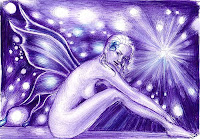Catch Bobby Ray's orbs, and Hayley playing the role of a Paranormal Phenomenon, haha. I think this is one of the most original ways I've ever seen this concept depicted in, and I really liked it: do you see the moving, living entity through still photographs? Wonderful. I think it describes our condition perfectly (and wouldn't it make her the Light?)
"I could use a dream, a genie or a wish" - you forgot: how about a fairy? ;)
By me:

By Corina:
 I was struck by the similarities between these two drawings, because we had never looked at each other's work before, and because we both refer to the respective Muse of poets who were burdened by their fame - which in turn resonates with Airplanes above.
I was struck by the similarities between these two drawings, because we had never looked at each other's work before, and because we both refer to the respective Muse of poets who were burdened by their fame - which in turn resonates with Airplanes above.The Muses are Fairy women because they are visualized in the 4th dimension (the famous "wings" are symbolic of the soul's ability to fly the Cosmic Flight; they are not --as some people also believe about Angels-- wings of the body...).
Let me show you something...
Antonio Vivaldi: Andromeda Liberated (A Venetian Serenade). In those days, when you said "Concert", this is what people would understand by it, and would attend it just as we attend Pop concerts nowadays. It seems that Andromeda was burdened by her "fortune", which was the only thing her "admirer" saw - as opposed to Perseus (ancestor of the Persians) who saw her for who she was (another kind of "treasure"). The figure of the Monster (Vortex) is set to devour her if she is not liberated from this form of materialism.
Aria 14: Con dolce mormorio [6:03] (Cassiope)
Recitativo 17: Perseo, che tardi più [1:17] (Daliso)
Duo: Sposo amato / Cara sposa [3:23] (Andromeda & Perseo)
Coro 3: Riconosc'in voi [2:31] (Daliso)
Andromeda: Simone Kermes (soprano)
Perseo: Max Emanuel Cencic (countertenor)
Cassiope: Katerina Beranova (soprano)
Daliso: Mark Tucker (tenor)










